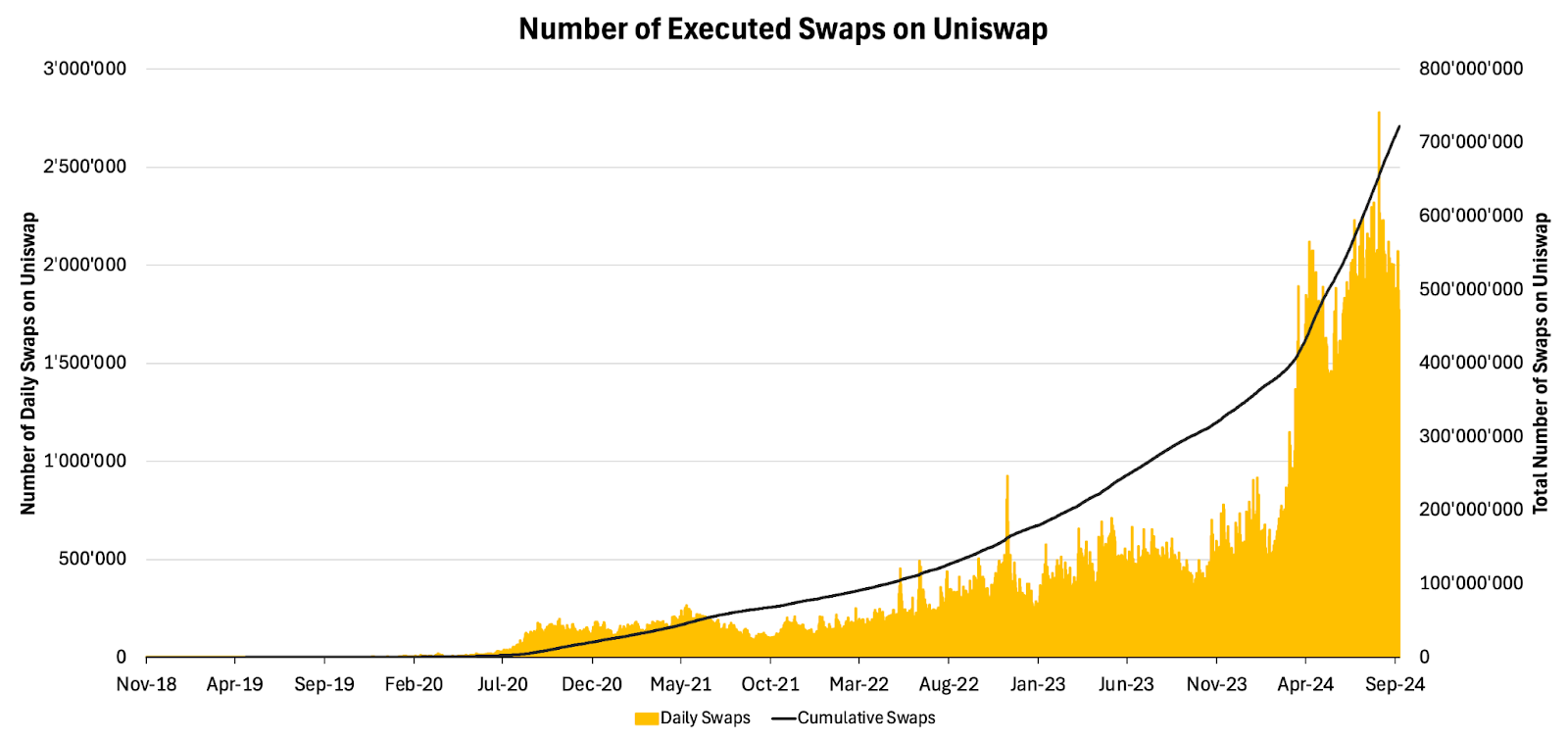.jpg)
Ethereum's Evolution: From ETF Flows to Core Portfolio Asset and Beyond
Ethereum has consistently ranked as the second-largest digital asset by market capitalization for most of the past eight years and remains the leading smart contract Layer 1 blockchain since its inception. Moreover, Ethereum stands out as one of the few digital assets with current regulatory clarity. In May of this year, the SEC approved multiple Ether spot ETFs, marking a significant step in regulatory acceptance. Then in June, the SEC's confirmation that ETH is not a security, alongside the CFTC's classification of ETH as a commodity, further reinforced its regulatory clarity.
Figure 1 – Cumulative Ethereum ETF Net Flows

With regulatory clarity taking hold and the approval of ETH spot ETFs, investors now have a registered way to invest in ETH. However, unlike the highly anticipated Bitcoin ETFs, ETH ETFs have struggled to capture similar demand. Their launch was poorly timed, coinciding with the Japanese Yen Unwind Trade and other unfavorable macroeconomic conditions, resulting in $600 million in outflows since their debut. However, as the macro-environment looks to improve—with the Fed cutting interest rates by 50 basis points (bps) and traditional financial markets reaching all-time highs—investors traditionally become more risk-on, which could shift attention toward higher-risk assets like ETH. This environment sets the stage for Ethereum to potentially shine as a tech or growth sleeve within portfolios, offering investors an opportunity to capitalize on the ongoing innovation and adoption of blockchain technology as a core pillar of the digital economy.
Ethereum’s versatility and broad range of use cases make it a compelling addition to the tech or growth sleeve of a diversified investment portfolio, similar to traditional ETFs like QQQ or XLK. Unlike traditional assets, ETH offers targeted exposure to the evolving digital landscape, striving to capture the growth potential of the rapidly expanding blockchain ecosystem. As the leading smart contract platform, Ethereum not only provides access to the cutting edge of decentralized applications but also mirrors the innovation driving the broader shift toward decentralized technologies. Its increasing adoption, ongoing network upgrades, and current regulatory clarity further enhance its appeal, positioning ETH as a strategic investment rather than just a speculative asset. By including Ethereum in a portfolio, investors can help balance risk and reward while participating in the transformative potential of blockchain technology, positioning themselves at the forefront of digital innovation and diversification.
This strategic positioning within portfolios is driven by Ethereum’s multifaceted capabilities that extend beyond simple price speculation. Despite early setbacks, Ethereum continues to attract a growing user base as its diverse use cases gain wider recognition, prompting many new investors to explore its real-world applications. As the backbone of a vast array of decentralized applications, Ethereum powers innovation across multiple sectors, including finance, gaming, digital art & ownership, and artificial intelligence. Central to this transformation is decentralized finance (DeFi), Ethereum’s most prominent use case, which is attempting to revolutionize traditional financial services and fostering a more transparent and accessible financial system.
DeFi: Ethereum’s Killer Use Case
DeFi is a blockchain-based financial ecosystem that removes the need for intermediaries, using smart contracts to facilitate lending, borrowing, trading, and earning interest on assets. This 24/7 system democratizes access to financial services, reducing costs and increasing transparency. DeFi also includes decentralized prediction markets, like Polymarket, where users can wager on real-world outcomes, turning crowd-sourced insights into valuable data. Stablecoins, integral to DeFi, offer a stable value for transactions, cross-border payments, and savings, providing financial autonomy beyond traditional systems.
Key DeFi use cases include:
Lending and Borrowing: Protocols like Aave and Compound enable users to lend assets to earn interest or borrow against collateral without banks. Automated through smart contracts, these platforms manage collateral, interest rates, and repayments, enhancing accessibility and creating passive income opportunities. With over $17 billion in total value locked (TVL)—the DeFi equivalent of assets under management—in Ethereum-based lending and borrowing protocols, Compound and Aave alone account for more than 75% of this market. These protocols not only enhance financial accessibility but also create new opportunities for passive income, fundamentally redefining lending and borrowing in the digital era.
Figure 2 – Borrow & Lending TVL on Ethereum Segmented by Protocols

Trading: Uniswap revolutionized trading— The decentralized exchanges (DEX) pioneered the Automated Market Maker (AMM) model, where liquidity pools replace order books, allowing users to trade directly with smart contracts. This innovation has simplified the trading process and made it more accessible to anyone with an internet connection.
Dexs allow users to swap tokens, provide liquidity, and trade derivatives without intermediaries. Uniswap alone sees millions of transactions daily, underscoring the demand for decentralized trading solutions.
Figure 3 – Total Number of Swaps/Traded Executed via the Different Iterations of Uniswap

Stablecoins: Stablecoins like USDT, USDC, and DAI are pivotal in DeFi, offering a stable, dollar-pegged value critical for transactions, remittances, and as collateral. Their use has surged, with the market cap of non-algorithmic stablecoins now exceeding $170 billion. . Notably, stablecoins now consistently surpass Bitcoin in daily transaction volume, underscoring their critical role in facilitating efficient, low-cost payments. Their integration with major platforms like Visa, Stripe, and Shopify further cements their utility, bridging the gap between traditional finance and the decentralized world and driving mass adoption within the crypto space.
Figure 4 – Weekly Volume of Stablecoins and Bitcoin (USD)

Prediction Markets: Prediction markets like Polymarket leverage Ethereum to let users bet on real-world events, from elections to sports, using smart contracts for transparent, automated transactions without intermediaries. With over $1 billion wagered and rising demand, these platforms harness collective insights to forecast outcomes, aid decision-making, and offer tools for hedging against uncertainty, transforming how we interact with information.
Tokenizing Real-World Assets: Revolutionizing Finance and Accessibility
Real-world assets (RWAs) are increasingly being tokenized on Ethereum, transforming financial innovation and accessibility. By representing assets like stocks, bonds, real estate, and fine art as digital tokens, blockchain enhances liquidity, transparency, and democratizes access through fractional ownership. The value of RWAs on Ethereum has surpassed $4 billion, with institutions like BlackRock leading the way by tokenizing hundreds of millions in money market funds. Ethereum’s smart contracts enable 24/7 trading, instant settlement, and lower costs, positioning blockchain as a game-changer in how assets are issued, managed, and exchanged.
Gaming on Ethereum: Revolutionizing Digital Ownership and Player Engagement
Ethereum is transforming digital ownership and player engagement in gaming, enabling decentralized games where players truly own in-game assets through NFTs. This technology allows gamers to buy, sell, and trade items, creating real-world value and new revenue streams. Games like Axie Infinity and Gods Unchained showcase the potential of play-to-earn models, where players earn cryptocurrency rewards simply by playing. Ethereum's blockchain ensures transparency, fair play, and community-driven governance, redefining digital worlds by blending entertainment with economic opportunity in ways traditional gaming platforms can't match.
NFTs: Redefining Art and Ownership in the Digital and Physical Worlds
Ethereum’s blockchain is transforming the digital art world through NFTs, which redefine ownership and provenance by providing verifiable proof of authenticity for digital artworks. This empowers artists to monetize their creations directly, bypassing traditional intermediaries, while offering collectors a transparent system to buy, sell, and trade unique assets. Ethereum's role as the primary platform for NFTs has fueled a dynamic digital art ecosystem that extends beyond art to music, collectibles, and digital media. NFTs also hold transformative potential for tokenizing physical assets like car titles and real estate, providing secure, transferable digital certificates of ownership. This simplifies transactions, reduces costs, and democratizes access to traditionally illiquid markets. By bridging the physical and digital worlds, NFTs are revolutionizing asset management and exchange, positioning Ethereum as a key platform for future ownership models.
AI x Blockchain: Enhancing Security and Verification
Artificial Intelligence (AI) is set to intersect with blockchain technology in ways that enhance security, privacy, and autonomy, with Ethereum playing a pivotal role in this transformation. One emerging use case is proving human identity in a world increasingly filled with AI agents and deepfakes. By integrating blockchain-based verification systems, AI can help authenticate that users are humans rather than automated bots, enhancing security across digital interactions. Additionally, the development of decentralized AI models on Ethereum offers an alternative to the current landscape dominated by large corporations like Facebook and OpenAI. These decentralized models allow individuals to retain ownership of their data, ensuring that AI systems are trained on publicly available,
Conclusion
Ethereum’s journey from being a pioneer in the world of decentralized finance to becoming a cornerstone asset in diversified portfolios underscores its multifaceted value proposition. As regulatory clarity enhances investor confidence, and its ecosystem continues to innovate and expand, Ethereum is cementing its role as a key player in the digital economy. From transforming traditional financial services with DeFi and revolutionizing ownership with NFTs to tokenizing real-world assets and integrating with AI, Ethereum is reshaping industries and pushing the boundaries of what blockchain technology can achieve. Its versatility, continuous evolution, and the ability to drive meaningful change across various sectors make it not just a speculative asset but a strategic, growth-oriented component of any forward-looking investment portfolio. As the landscape of finance and technology converges, Ethereum stands at the forefront, offering compelling opportunities for investors to participate in the next wave of digital innovation.


.svg)



_logo.svg)

.svg.png)